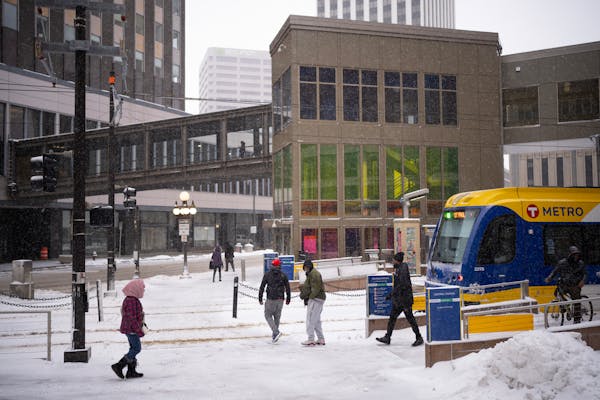Property values in Ramsey County appear to be stabilizing, a new annual assessor's report shows.
The COVID-19 pandemic sparked a meteoric rise in housing prices, fueled by low supply and strong demand, all helped by low interest rates. Values remain high, but growth slowed in 2023 due to higher mortgage rates and low inventory.
While most property values are returning to a pre-pandemic growth rate overall, values in downtown St. Paul and apartments throughout the county declined from last year.
Residential properties — single-family homes, townhomes, condos, duplexes and triplexes — make up more than two-thirds of all property value in Ramsey County. These types of properties saw values increase at greater rates than other property classes, but less quickly than in the height of the pandemic.
Other sectors have seen values level out more. Last year's assessments showed major growth in industrial property values, especially in the suburbs, County Assessor Patrick Chapman said.
"There's so much internet commerce that those flex warehouses have become extremely valuable," he said. "But we even saw those stabilize this year. All of the spikes of last year kind of stabilized."
Here are four other takeaways from the assessor's report and what they mean for Ramsey County and its residents:
1. The overall value of apartments declined from last year.
Apartment buildings lost 4% of their assessed value relative to 2023. This trend extends beyond Ramsey County: Apartment building owners say expenses are rising faster than revenues. Higher interest rates have led to fewer sales and lower prices.
It's not all bad: The assessor's report said demand remains strong despite several years of new apartment projects.
The trend is slightly more pronounced in St. Paul, where apartment values dropped 4.5%, than in the suburbs, where they dropped 3.4%.
Is St. Paul's first-in-the-Midwest rent stabilization policy to blame? Critics say the 3% cap on annual rent increases is contributing to the decline in values. Chapman said it's too soon to tell whether that's true — but it's something his office is studying.
2. Downtown St. Paul saw the biggest drop in property values.
As downtown St. Paul boosters look to revitalize the city's core, data shows the area's growth lags behind the rest of the city: The market value of all property in downtown St. Paul dropped 6.1%, or $133 million — far more than other neighborhoods.
All property classes took a hit here: The rise of hybrid work continued to plague office buildings, causing downtown's total commercial property value to drop 4%. The overall value of downtown apartment buildings declined by 9%. Residential was down 4%, while industrial was down 1%.
A 2021 study showed that downtown makes up about 2% of St. Paul's land area but produced 9% of citywide tax revenue.
In its new strategic plan, the nonprofit St. Paul Downtown Alliance listed office-to-residential conversions as a key priority to revitalize downtown.
"St. Paul has some advantages, because they have some buildings with smaller plates that you can turn into apartment use pretty easy," Chapman said.
About 42% of downtown St. Paul's property value is commercial. Its 4% drop paled in comparison to downtown Minneapolis, which saw a 13% decrease in commercial values.
"Their central business district is quite a bit more office-driven than ours," Chapman said.
3. The median suburban home in Ramsey County increased in value. But how much varied from city to city — and neighborhood
Residential properties saw the biggest gains of any property class in 2024.
In the suburbs, the median single-family home, estimated at $366,200, gained about $12,000 in value in the last year.
Biggest increases were North Oaks (up 7.6%) and Falcon Heights (up 7.4%).
In Little Canada, the median single-family home's value remained flat.
While no St. Paul neighborhoods saw their median single-family homes drop in value, the amount property values went up varied across the city.
St. Anthony Park and Summit Hill led the pack, with 6.8% and 6.7% increases, respectively. Properties in some East Side neighborhoods, including Payne-Phalen and the Greater East Side, saw the smallest increases, at less than 1.5%.
4. Unclear whether homeowners will pay more tax
Chapman said residential property value increases could shift the tax burden toward homeowners next year. But for those who homestead their properties, that could be offset by an increase in the homestead market value exclusion passed by the Minnesota Legislature.
The statewide change means homesteaded properties valued at $517,200 or less (up from $413,800) will see part of their value excluded from tax, Chapman said.
Chapman characterized a 4% growth in residential values as back to normal.
"The housing market is really stabilizing," he said, but noted all-time lows in inventory.
If interest rates come down, that could change, he said, but politics could play a role, too:
"It's a presidential election year ... In the real estate market, that usually equals not a lot of movement," he said.

Want to share info with the Star Tribune? How to do it securely

'Safe recovery sites' would offer syringes, naloxone and more to people using drugs. The plan could be in peril.
New Minnesota GOP leaders seek peace with party's anti-establishment wing

Who is Republican Lisa Demuth, Minnesota's first House speaker of color?

